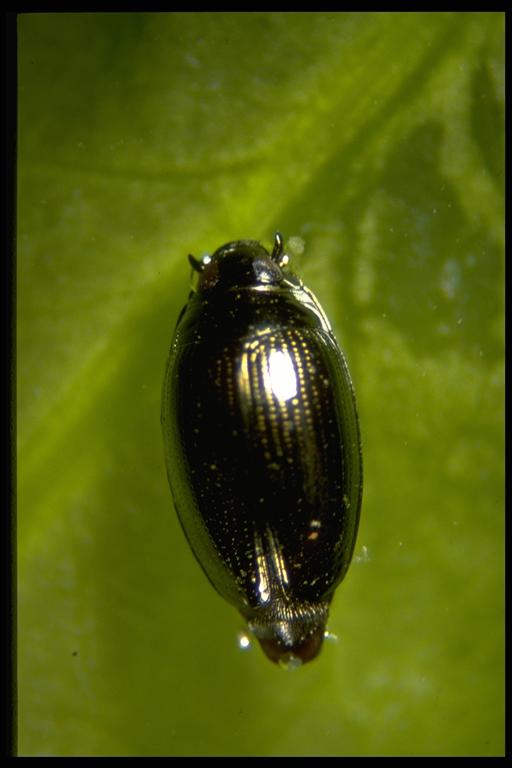
A whirligig beetle, Gyrinus sp. (Coleoptera: Gyrinidae). Photo by Drees.
Common Name: Whirligig beetle
Scientific Name: Gyrinus sp.
Order: Coleoptera
Description: Whirligig beetles are black, or nearly black, and 1/8 to 1-3/8 inches (3 to 35 mm) long. They are flattened dorsoventrally and streamlined for aquatic life. The eyes are divided allowing them to see both above and below the water surface where they are usually found. The forelegs are relatively long and often held forward. They are easily recognized by the erratic swimming behavior on the surface of the water. Larvae are elongate and often have sideways (lateral) extensions on the abdomen, up to 1 inch long and have four terminal hooks of the very tip of the abdomen.
There are a number of aquatic beetles that have the same general body shape. The separated eyes of Gyrinidae are characteristic of adults.
Life Cycle: Pupation occurs in cocoons on plants or on the shore.
Habitat and Food Source(s): Mouthparts are for chewing. These beetles often congregate in both flowing and still water, especially streams and ponds. Adults feed on organisms on the surface of the water or scavenge debris. They spend much of their life on the surface of water. Some Dineutus species can secrete a milky substance which emits an odor that resembles ripe apples while Gyrinus species emit an unpleasant odor. They can swim rapidly. Adults feed on organisms on the water surface or by scavenging debris. Larvae are predators on aquatic organisms. Larvae are seldom seen but are found in the bottom of streams and ponds. Adults are sometimes attracted to lights.
Pest Status: Beneficial; predaceous larvae; medically harmless.
Management: None, this is a beneficial insect.
For additional information, contact your local Texas AgriLife Extension agent or search for other state Extension offices.
Literature: McCafferty 1981.